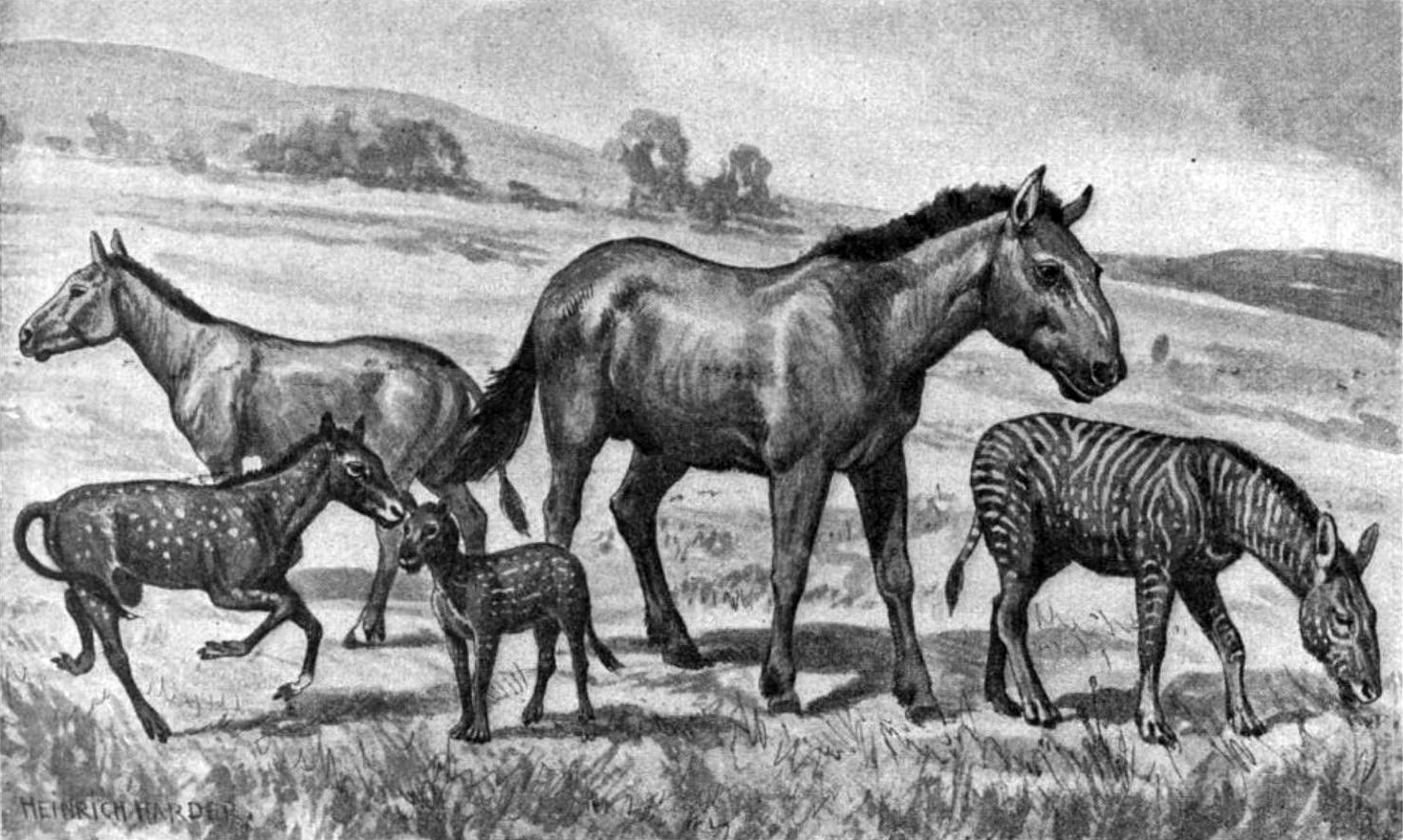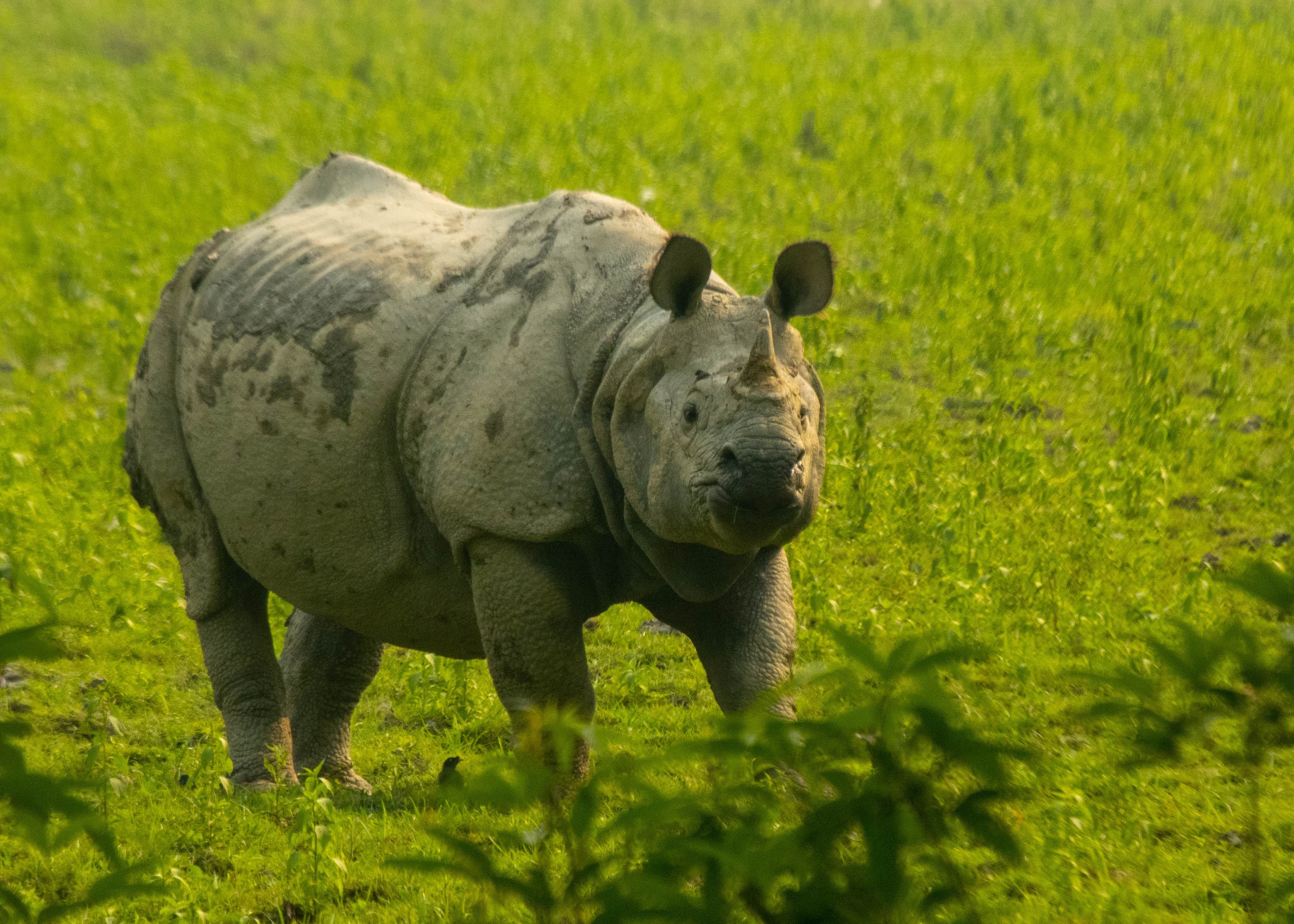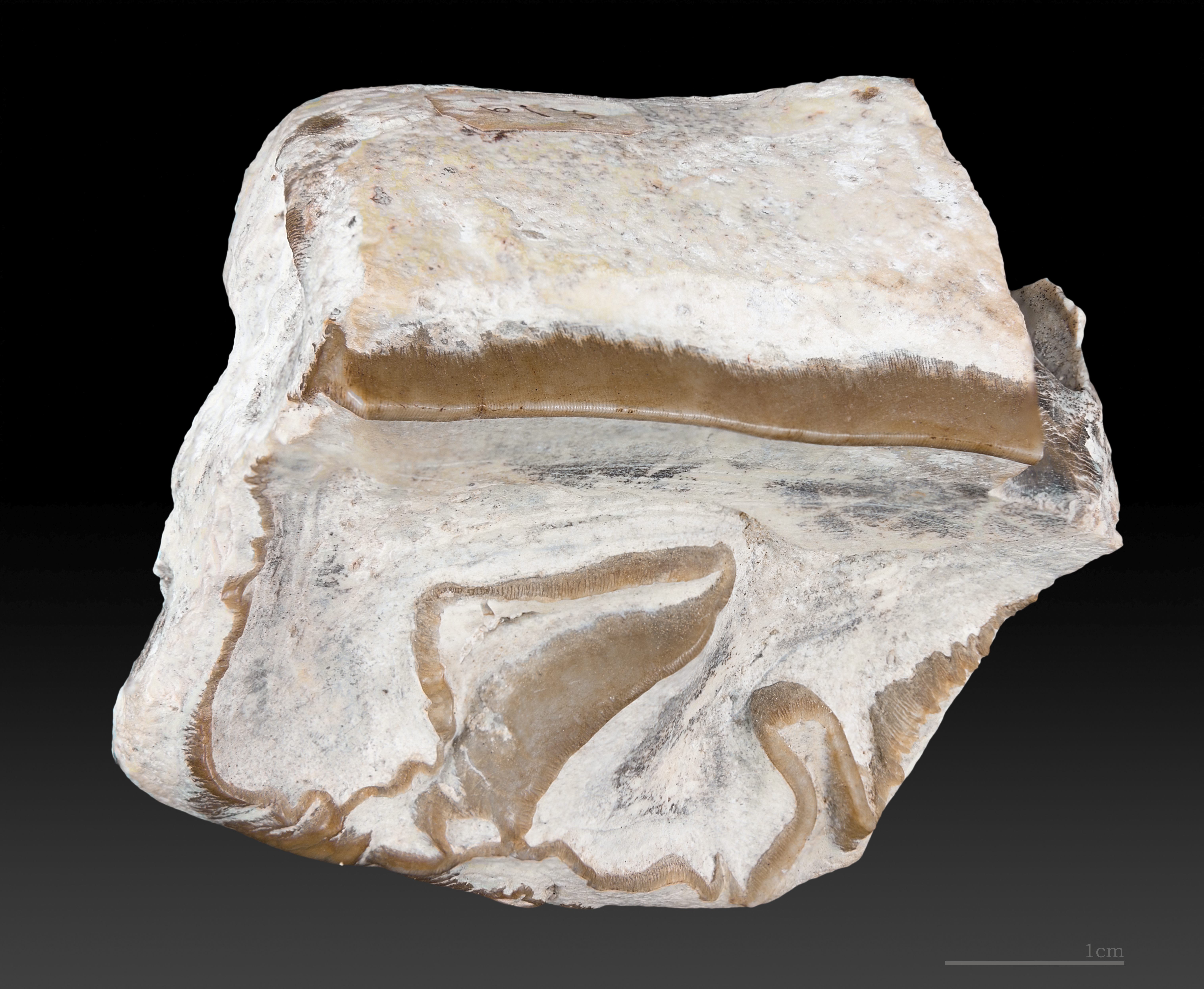|
Perissodactyla
Perissodactyla (, ), or odd-toed ungulates, is an order of ungulates. The order includes about 17 living species divided into three families: Equidae (horses, asses, and zebras), Rhinocerotidae (rhinoceroses), and Tapiridae (tapirs). They typically have reduced the weight-bearing toes to three or one of the five original toes, though tapirs retain four toes on their front feet. The nonweight-bearing toes are either present, absent, vestigial, or positioned posteriorly. By contrast, artiodactyls (even-toed ungulates) bear most of their weight equally on four or two (an even number) of the five toes: their third and fourth toes. Another difference between the two is that perissodactyls digest plant cellulose in their intestines, rather than in one or more stomach chambers as artiodactyls, with the exception of Suina, do. The order was considerably more diverse in the past, with notable extinct groups including the brontotheres, palaeotheres, chalicotheres, and the paracer ... [...More Info...] [...Related Items...] OR: [Wikipedia] [Google] [Baidu] |
Rhinoceros Male 2003
A rhinoceros ( ; ; ; : rhinoceros or rhinoceroses), commonly abbreviated to rhino, is a member of any of the five extant species (or numerous extinct species) of odd-toed ungulates (perissodactyls) in the family Rhinocerotidae; it can also refer to a member of any of the extinct species of the superfamily Rhinocerotoidea. Two of the extant species are native to Africa, and three to South and Southeast Asia. Rhinoceroses are some of the largest remaining megafauna: all weigh over half a tonne in adulthood. They have a herbivorous diet, small brains for mammals of their size, one or two horns, and a thick , protective skin formed from layers of collagen positioned in a lattice structure. They generally eat leafy material, although their ability to ferment food in their hindgut allows them to subsist on more fibrous plant matter when necessary. Unlike other perissodactyls, the two African species of rhinoceros lack teeth at the front of their mouths; they rely instead on their ... [...More Info...] [...Related Items...] OR: [Wikipedia] [Google] [Baidu] |
Rhinocerotidae
A rhinoceros ( ; ; ; : rhinoceros or rhinoceroses), commonly abbreviated to rhino, is a member of any of the five extant taxon, extant species (or numerous extinct species) of odd-toed ungulates (perissodactyls) in the family (biology), family Rhinocerotidae; it can also refer to a member of any of the extinct species of the superfamily Rhinocerotoidea. Two of the extant species are native to Africa, and three to South Asia, South and Southeast Asia. Rhinoceroses are some of the largest remaining megafauna: all weigh over half a tonne in adulthood. They have a herbivore, herbivorous diet, small brains for mammals of their size, one or two horns, and a thick , protective skin formed from layers of collagen positioned in a crystal structure, lattice structure. They generally eat leafy material, although their ability to ferment food in their colon (anatomy), hindgut allows them to subsist on more fibrous plant matter when necessary. Unlike other perissodactyls, the two African ... [...More Info...] [...Related Items...] OR: [Wikipedia] [Google] [Baidu] |
Tapiridae
Tapirs ( ) are large, herbivorous mammals belonging to the family Tapiridae. They are similar in shape to a pig, with a short, prehensile nose trunk (proboscis). Tapirs inhabit jungle and forest regions of South and Central America and Southeast Asia. They are one of three extant branches of Perissodactyla (odd-toed ungulates), alongside equines and rhinoceroses. Only a single genus, ''Tapirus'', is currently extant. Tapirs migrated into South America during the Pleistocene epoch from North America after the formation of the Isthmus of Panama as part of the Great American Interchange. Tapirs were formerly present across North America, but became extinct in the region at the end of the Late Pleistocene, around 12,000 years ago. Name The term ''tapir'' comes from the Portuguese-language words , , which themselves trace their origins back to Old Tupi, specifically the term . This word, according to Eduardo de Almeida Navarro, referred in a more precise manner to the species '' ... [...More Info...] [...Related Items...] OR: [Wikipedia] [Google] [Baidu] |
Chalicotheriidae
Chalicotheriidae (from Ancient Greek ''khálix'', "gravel", and ''theríon'', "beast") is an extinct family of herbivorous, odd-toed ungulate (perissodactyl) mammals that lived in North America, Eurasia, and Africa from the Middle Eocene to the Early Pleistocene. They are often called chalicotheres, a term which is also applied to the broader grouping of Chalicotherioidea. They are noted for their unusual morphology compared to other ungulates, such as their clawed forelimbs. Members of the subfamily Chalicotheriinae developed elongate gorilla-like forelimbs that are thought to have been used to grasp vegetation. They are thought to have been browsers on foliage as well as possibly bark and fruit. History of discovery The first chalicotheres remains discovered were ungual phalanges found near Eppelsheim, Germany in the early 19th century. These remains were considered to belong to gigantic pangolins by Georges Cuvier in 1822 while Johann Jakob Kaup in 1833 alternatively attr ... [...More Info...] [...Related Items...] OR: [Wikipedia] [Google] [Baidu] |
Brontotheriidae
Brontotheriidae is a family of extinct mammals belonging to the order Perissodactyla, the order that includes horses, rhinoceroses, and tapirs. Superficially, they looked rather like rhinos with some developing bony nose horns, and were some of the earliest mammals to have evolved large body sizes of several tonnes. They lived around 56–34 million years ago, until the very close of the Eocene. Brontotheres had a Holarctic distribution, with the exception of Western Europe: they occupied North America, Asia, and Eastern Europe. They were the first fossilized mammals to be discovered west of the Mississippi, and were first discovered in South Dakota. Characteristics and evolution This group has also been referred to as "Titanotheres." "Titan" refers to the mythological Greek gods who were symbols of strength and large size, and "theros" is Greek for "wild animal." "Bronto" is Greek for "thunder," which may be how this group got the nickname "thunder beasts." Brontotheres retai ... [...More Info...] [...Related Items...] OR: [Wikipedia] [Google] [Baidu] |
South American Tapir
The South American tapir (''Tapirus terrestris''), also commonly called the Brazilian tapir (from the Tupi ), the Amazonian tapir, the maned tapir, the lowland tapir, (Brazilian Portuguese), and ''la sachavaca'' (literally "bushcow", in mixed Quechua and Spanish), is one of the four recognized species in the tapir family (of the order Perissodactyla, with the mountain tapir, the Malayan tapir, and the Baird's tapir). It is the largest surviving native terrestrial mammal in the Amazon. Most classifications also include ''Tapirus kabomani'' (also known as the dwarf black tapir or the kabomani tapir) as also belonging to the species ''Tapirus terrestris'' (Brazilian tapir), despite its questionable existence and the overall lack of information on its habits and distribution. The specific epithet derives from ''arabo kabomani'', the word for tapir in the local Paumarí language. The formal description of this tapir did not suggest a common name for the species. The Karitiana ... [...More Info...] [...Related Items...] OR: [Wikipedia] [Google] [Baidu] |
Ungulate
Ungulates ( ) are members of the diverse clade Euungulata ("true ungulates"), which primarily consists of large mammals with Hoof, hooves. Once part of the clade "Ungulata" along with the clade Paenungulata, "Ungulata" has since been determined to be a polyphyletic and thereby invalid clade based on molecular data. As a result, true ungulates had since been reclassified to the newer clade Euungulata in 2001 within the clade Laurasiatheria while Paenungulata has been reclassified to a distant clade Afrotheria. Living ungulates are divided into two orders: Perissodactyla including Equidae, equines, rhinoceroses, and tapirs; and Artiodactyla including Bos, cattle, antelope, Sus (genus), pigs, giraffes, camels, Ovis, sheep, deer, and Hippopotamidae, hippopotamuses, among others. Cetaceans such as Whale, whales, Dolphin, dolphins, and Porpoise, porpoises are also classified as artiodactyls, although they do not have hooves. Most terrestrial ungulates use the hoofed tips of their toes ... [...More Info...] [...Related Items...] OR: [Wikipedia] [Google] [Baidu] |
Equidae
Equidae (commonly known as the horse family) is the Taxonomy (biology), taxonomic Family (biology), family of Wild horse, horses and related animals, including Asinus, asses, zebra, zebras, and many extinct species known only from fossils. The family evolved more than 50 million years ago, in the Eocene epoch, from a small, multi-toed ungulate into larger, single-toed animals. All Extant taxon, extant species are in the genus ''Equus (genus), Equus'', which originated in North America. Equidae belongs to the order Perissodactyla, which includes the extant tapirs and rhinoceros, and several extinct families. It is more specifically grouped within the superfamily (taxonomy), superfamily Equoidea, the only other family being the extinct Palaeotheriidae. The term equid refers to any member of this family, including any equinae, equine. Evolution The oldest known fossils assigned to Equidae were found in North America, and date from the early Eocene epoch, 54 million years ago. Th ... [...More Info...] [...Related Items...] OR: [Wikipedia] [Google] [Baidu] |
Indian Rhinoceros
The Indian rhinoceros (''Rhinoceros unicornis''), also known as the greater one-horned rhinoceros, great Indian rhinoceros or Indian rhino, is a species of rhinoceros found in the Indian subcontinent. It is the second largest living rhinoceros species, with adult males weighing and adult females . Its thick skin is grey-brown with pinkish skin folds. It has a single horn on its snout that grows up to long. Its upper legs and shoulders are covered in wart-like bumps, and it is nearly hairless aside from the eyelashes, ear fringes and tail brush. The Indian rhinoceros is native to the Indo-Gangetic Plain and occurs in 12 protected areas in northern India and southern Nepal. It is a Grazing (behaviour), grazer, eating mainly grass, but also twigs, leaves, branches, shrubs, flowers, fruits and aquatic plants. It is a largely solitary animal, only associating in the breeding season and when rearing calves. Females give birth to a single calf after a gestation of 15.7 months. Th ... [...More Info...] [...Related Items...] OR: [Wikipedia] [Google] [Baidu] |
Tapiroidea
Tapiroidea is a superfamily of Perissodactyla, perissodactyls which includes the modern tapir, tapirs and their extinct relatives. Taxonomically, they are placed in suborder Ceratomorpha along with the rhino superfamily, Rhinocerotoidea. The first members of Tapiroidea appeared during the Early Eocene, 55 million years ago, and were present in North America and Asia during the Eocene. Tapiridae first appeared during the early Oligocene in Europe, and are thought to have originated from the tapiroid family Helaletidae. Taxonomy *Superfamily Tapiroidea **Family †Deperetellidae ***Genus †''Bahinolophus'' ***Genus †''Deperetella'' ***Genus †''Irenolophus'' ***Genus †''Teleolophus'' **Family Tapiridae ***Genus †''Eotapirus'' ***Genus †''Miotapirus'' ***Genus †''Nexuotapirus'' ***Genus †''Paratapirus'' ***Genus †''Plesiotapirus'' ***Genus †''Protapirus'' (syn. ''Tanyops'') ***Genus †''Tapiravus'' ***Genus ''Tapirus'' **Family †Helaletidae ***Genus †''Colod ... [...More Info...] [...Related Items...] OR: [Wikipedia] [Google] [Baidu] |
Amynodontidae
Amynodontidae ("defensive tooth") is a family of extinct perissodactyls related to true rhinoceroses. They are commonly portrayed as semiaquatic hippo-like rhinos but this description only fits members of the Metamynodontini; other groups of amynodonts like the cadurcodontines had more typical ungulate proportions and convergently evolved a tapir-like proboscis. The Greek name of the family describes their tusks, derived from enlarged canine teeth. Odd-toed ungulates are herbivores, so these tusks would have been used either to deter or defend against predators (as suggested by the name) or perhaps in fights among males. Their fossils have been found in North America, and Eurasia ranging in age from the Middle Eocene to the Early Oligocene, with a single genus (''Cadurcotherium'') surviving into the Late Oligocene in South Asia (Pakistan). Taxonomy †Amynodontidae *Subfamily Amynodontinae **Tribe Cadurcodontini ***Genus '' Cadurcodon'' ***Genus '' Lushiamynodon'' ***Genu ... [...More Info...] [...Related Items...] OR: [Wikipedia] [Google] [Baidu] |
Palaeotheriidae
Palaeotheriidae is an extinct family of herbivorous perissodactyl mammals that inhabited Europe, with less abundant remains also known from Asia, from the mid-Eocene to the early Oligocene. They are classified in Equoidea, along with the living family Equidae (which includes zebras, horses and asses). Morphology Palaeotheres ranged widely in size, from small species like '' Palaeotherium lautricense,'' which is estimated to have only weighed to large species like '' Palaeotherium magnum'', which are comparable in size to living equines, with body masses over . Their teeth are brachydont (low crowned). According to Danilo et al. 2013., paleotheriids are distinguished from other equoids by one unambiguous synapomorphy "the nasal notch opening distally to the canine, above the postcanine diastema" and two unambiguous character state changes "an average metaconule on he fourth premolar and "an oblique metastyle on he first and second molars. Taxonomy Palaeotheriidae is ge ... [...More Info...] [...Related Items...] OR: [Wikipedia] [Google] [Baidu] |










